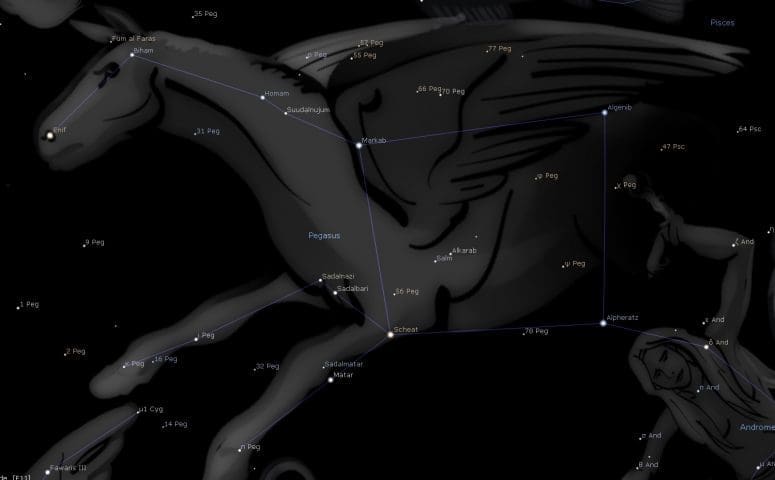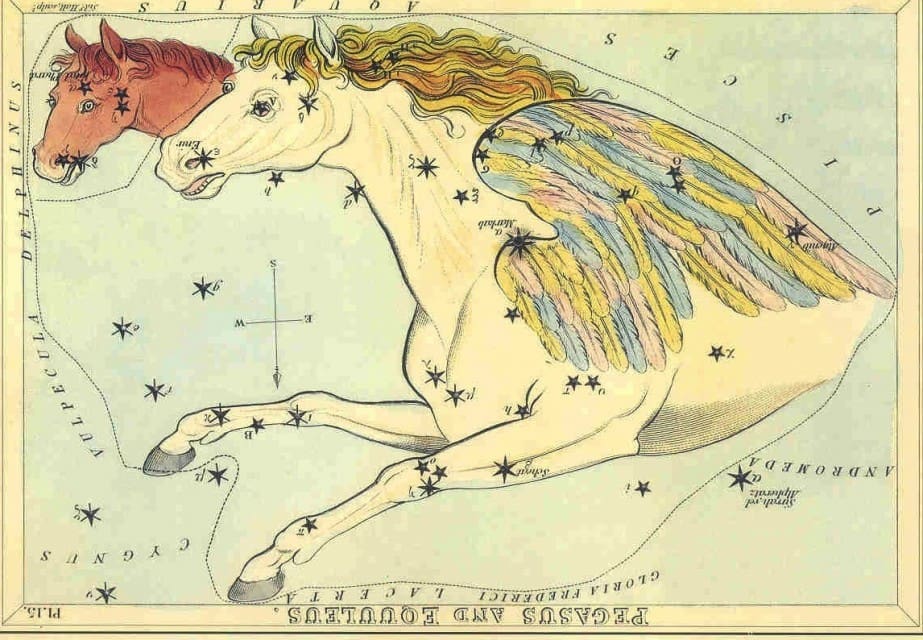Pegasus Constellation Astrology
Pegasus constellation, the Winged Horse, is a northern constellation above Aquarius constellation and below Cygnus constellation, between Delphinius constellation and Andromeda constellation. It spans 40 degrees of the zodiac in the signs of Aries and Pisces and contains 16 named fixed stars.Pegasus Constellation Stars
| 2000 | B | Star Name | Mag. | Orb |
|---|---|---|---|---|
| 01♓52 | ε | Enif | 2.38 | 2°00′ |
| 05♓18 | ν | Fum al Faras | 4.86 | 1°00′ |
| 06♓49 | θ | Biham | 3.52 | 1°20′ |
| 08♓55 | κ | Jih | 4.14 | 1°00′ |
| 16♓08 | ζ | Homam | 3.41 | 1°20′ |
| 17♓56 | ξ | Suudalnujum | 4.20 | 1°00′ |
| 19♓32 | π | Woo | 4.28 | 1°00′ |
| 23♓02 | λ | Sadalnazi | 3.97 | 1°00′ |
| 23♓28 | α | Markab | 2.49 | 1°50′ |
| 24♓22 | μ | Sadalbari | 3.51 | 1°20′ |
| 24♓54 | ο | Sadalmatar | 4.80 | 1°00′ |
| 25♓42 | η | Matar | 2.93 | 1°40′ |
| 29♓22 | β | Scheat | 2.44 | 2°00′ |
| 01♈02 | τ | Kerb | 4.58 | 1°00′ |
| 01♈58 | υ | Alkarab | 4.42 | 1°00′ |
| 09♈09 | γ | Algenib | 2.83 | 1°40′ |
Constellation Pegasus the Flying Horse gives ambition, vanity, intuition, enthusiasm, caprice, and bad judgment. It prevails against the diseases of horses and preserves horsemen in battle. According to Ptolemy, the bright stars are like Mars and Mercury (high enterprise, combative, destructive. If rising, rash, very obstinate, ruined by headstrong and precipitate conduct. If culminating, changeable in business.) [1]
The constellation portends events concerning ships and the ocean and also changes in the weather. In medieval times it was said to indicate vain individuals with a great deal of ambition but very poor judgment. [2]
Pegasus, like birds, angels, and most celestial winged creatures, is an allegory for the superior spiritual power that the hero first sought out to aid him in his task, and the Owl represents the wisdom side of that same power. [3]
The stars of the Great Square in-closing the body of the Horse (the Great Square of Pegasus marked by the stars Alpheratz (alpha Andromeda), Scheat, Markab, and Algenib). Mythologically he was the son of Neptune and Medusa, sprung by his father’s command from the blood of the latter which dropped into the sea after her head had been severed by Perseus; and he was named either from Pegai, the Springs of the Ocean, the place of his birth, or from Pegos, Strong. He was snowy white in color, and the favorite of the Muses, for he had caused to flow their fountain Pirene on Helicon,— or Hippocrene on the Acro Corinthus, — whence came one of the constellation titles, Fontis Musarum Inventor…
Pegasus then rose alone to his permanent place among the stars, becoming the Thundering Horse of Jove that carried the divine lightning… Brugsch mentions as in its location an Egyptian constellation, the Servant; and some of its stars would seem to be shown on the Denderah planisphere as a Jackal. [4]
Pegasus the winged Horse will appear and gallop aloft in the heavens. It will bring forth people endowed with swiftness of movement and limbs alert to perform every task. One man will cause his horse to wheel round in caracoles, and proudly mounted on its back he will wage war from on high; horseman and soldier in one. Another will possess the ability to rob the racecourse of its true length such is his speed that he will seem to dissemble the movement of his feet and make the ground vanish before him. Who more swiftly could fly back from the ends of the earth as a messenger or with light foot to the earth’s ends make his way? He will also heal a horse’s wounds with the sap of common plants, and will know the herbs which bring aid to an animal’s limbs and those which grow for the use of man. [5]In the Denderah Zodiac there are two characters immediately below the horse, Pe and ka. Peka or Pega, is in Hebrew the chief, and Sus is horse. So that the very word (Pegasus) has come down to us and has been preserved through all the languages. The names of the stars in this constellation declare to us its meaning. There are 89 altogether; one of the 1st magnitude, two of the 2nd, three of the 3rd, nine of the 4th, etc. And, as astronomers testify, “they render Pegasus peculiarly remarkable.”
The brightest α (on the neck of the horse at the junction of the wing), comes down to us with the ancient Hebrew name of Markab, which means returning from afar. The star β (in the near shoulder) is called Scheat, i.e., who goeth and returneth. The star γ (at the tip of the wing) bears an Arabic name Al Genib, who carries. The star ε (in the nostril) is called Enif (Arabic), the water. The star η (in the near leg) is called Matar (Arabic), who causes to flow.
These names show us that we have to do with no mere horse. A winged horse is unknown to nature. It must therefore be used as a figure; and it can be a figure only of a person, even of Him who is “the Branch,” as the star Enif shows, who said, “If I go away I will come again,” as the star Scheat testifies. He who procured these blessings for the redeemed by His Atonement, is quickly coming to bring them; and is soon returning to pour them forth upon a groaning creation. This is the lesson of Pegasus. [6]
Pegasus in Mundane Astrology
In mundane astrology, Pegasus is associated with drowning, accidents, catastrophes, earthquakes, tsunamis, storms, floods, shipwrecks, mining accidents, airplane accidents, falling accidents, shooting down from high, horses, jockeys, transportation, communications, space travel, exploration, pioneering, science, invention and heroism.
The Age of Pegasus
The fixed star Scheat in the constellation Pegasus is at the Aries point, so it is now the Age of Pegasus. A common question in astrology is, “When does the Age of Aquarius start?” This is debatable, but most astrologers agree it is a while off yet, though there also seems to be some consensus that we are living through an age of transition. “The precession of the astrological ages occurs due to the constellations and their fixed stars moving forward through the zodiac degrees at about one degree every 72 years, or 50.2675 seconds per year.” [7]
Whatever constellation is at zero degrees Aries is called the Constellation of the Age. Working out the exact beginning and ending of astrological ages is a gray area because the constellations are drawn differently in different sky maps. Below are some dates worked out using the precession of the first and last stars of a few constellations.
- 104 BC – 2817 AD: Age of Pisces
- 1345 AD – 4013 AD: Age of Pegasus
- 2694 AD – 5457 AD: Age of Aquarius
Based on the dates above, the Age of Aquarius starts around the end of the 27th century AD. People always talk about the end of the Age of Pisces and the beginning of the Age of Aquarius. Why limit ourselves to the twelve constellations along the ecliptic?
When a fixed star moves via precession of the equinoxes to zero degrees Aries, it is called the “Star of the Age”. The last one and the next one are both in the Pegasus constellation. This gives weight to Pegasus being more important to us now as a constellation of this age.
1925 AD: τ Pegasus, Kerb.
2045 AD: β Pegasus, Scheat.
Pegasus was born from the union of Neptune and Medusa. In the astrological influence of this constellation, we can see the themes of the sea and spirituality from Neptune and the rage from Medusa. Using an orb of influence for Scheat of 2 degrees, its influence goes over 100 years on either side of 2045 AD.
The story of Pegasus fits well with the constellation of this age: global warming, sea-level rise, and increased frequency and intensity of storms. At the personal level, spiritual implications are involved for humanity adjusting to these changes. “Only for some” can the higher manifestation of this star be perceived. Most of humanity fears these changes or ignores them as if they are not happening.
Pegasus Carrying us from the Ages of Pisces to Aquarius.
As the changes in our environment continue to escalate and the effect on the collective consciousness deepens, it will be up to the minority of people in tune with the spiritual side to help the rest of humanity through this difficult time. Astrologers, intuitive healers and all associated new-agers and freaks are becoming increasingly important and useful as the old security gives way to Uranian times.
Pegasus stretches across Pisces constellation and Aquarius constellation, so it could feasibly represent the evolution from one mode of thinking to another. The meaning of Pegasus seems to mirror that leap of consciousness needed to get into the supposed “Age Of Aquarius.”
Pegasus represents the shift in mindset from worshiping a God to becoming your own God. But looking at the stars in Pegasus, it is evident the transition will not be easy. Pegasus was born from the blood of Medusa (Algol) – his mother and his father, Poseidon, who had raped Medusa before she was turned into a Gorgon.
The Pegasus constellation gives ingenuity and a brilliant mind. But being so far ahead in your thoughts means others think you are mad. It gives you blind faith and does not make you inclined to look before you leap. A certain naivety can prove advantageous, however, because if you did see just how dangerous the path was, you would never take it. Yes, it’s a risk, but those who make it to their destination in one piece stand to get all the honor and riches that Markab promises. “Who dares wins” is his motto.
References
- Fixed Stars and Constellations in Astrology, Vivian E. Robson, 1923, p.174-175, 231.
- Fixed Stars and Judicial Astrology, George Noonan, 1990, p.29-30.
- The Living Stars, Dr. Eric Morse, 1988, p.127-128.
- Star Names: Their Lore and Meaning, Allen, 1889, p.321-322.
- Astronomica. Marcus Manilius, (1st century AD), p.350-353.
- The Witness of the Stars: 19. Pegasus (the Winged Horse), Bullinger, 1893.
- Planets in Transit, Robert Hand, 2001, p. 30.

